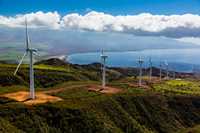Water Conservation
The Commission on Water Resource Management has broad powers and responsibilities to protect and manage Hawaii’s water resources. This includes the authority and duty to develop plans and programs to conserve water across the State of Hawaii.
As an island state, Hawaii has limited access to natural fresh water supplies. Competition for fresh water, increasing population and development pressures, the rising awareness of environmental water needs, and the impacts of global climate change require that Hawaii become as efficient as possible in its uses of limited fresh water supplies. In some areas of the state, demand for water is approaching the sustainable limits of supply, and these demands are expected to increase in the future. To sustain and protect our water for future generations, we must strive to be as efficient as possible in all our water uses. Water conservation is one of the least expensive way to stretch limited water supplies and defer costly new source development.
Find ways you can save water and save money by visiting the following county water department websites:
- County of Hawaii Department of Water Supply ➽
- Honolulu Board of Water Supply ➽
- County of Kauai Department of Water ➽
- County of Maui Department of Water Supply ➽
Hawaii WAVE Water Audit Program
Act 169, SLH 2016, requires the Commission to establish a water audit program and to provide technical assistance for affected water utilities. The Commission developed the Hawaii Water Audit Validation Effort (WAVE) program to fulfill the training requirements of Act 169. The Hawaii WAVE program will be implemented in two phases. Phase 1 will cover the County-owned public water systems (52 systems), whose water audits are due to the Commission by July 1, 2018. Phase 2 will cover public water systems serving a population of 1000 or more and those systems in water management areas (51 systems), whose water audits are due to the Commission by July 1, 2020.
The Hawaii WAVE program is comprised of four waves, each providing training and technical assistance with the utilities that will enable them to submit their validated water audits to the Commission on an annual basis. The Hawaii WAVE program builds internal capacity within the utilities to better understand water loss control and to utilize the water audit results to address issues within their respective systems.
 County-owned system schedule.
County-owned system schedule.
It is important to note that water audits are the first step in a comprehensive water loss control program. It will be up to each utility to use the water audit results and develop a cost-effective and data-driven water loss control program. Act 169 also requires that each water loss audit report submitted to the commission shall be accompanied by information identifying steps taken in the preceding year to increase the validity of data entered into the final audit, reduce the volume of apparent losses, and reduce the volume of real losses.
Act 169 authorized federal and private funding to help implement the purposes of the Act. The Hawaii WAVE program is funded by the U.S. EPA through the Hawaii Department of Health along with a contribution from The Hawaii Community Foundation.
Legislature Passes Landmark Water Audit Bill
In June 2016, Act 169, Session Laws of Hawaii 2016, was signed into law by Governor David Ige. The Act authorizes the Commission on Water Resource Management to develop and implement a water audit program and provide technical assistance (training) to counties and other public water system owners, enabling them to complete an initial validated standardized AWWA water audit. Thereafter, utilities are required to complete and submit validated water audits to the Commission on an annual basis. Water audits are the first step in developing a comprehensive water loss program for a water utility. The upcoming water audit program is summarized in an article for the AWWA-HI Section Fall 2016 newsletter.
Water System Audits
To implement the Hawaii Water Conservation Plan, the Commission published a water audit and loss control manual for public water systems. The Commission also held training workshops across the state in April 2014. There are numerous benefits of water loss auditing, including: helping utilities improve their knowledge of their distribution system, reducing water losses by identifying problem or risk areas, making more efficient use of existing supplies, improving public relations and reducing disruption in service to customers. Reducing the amount of water a utility needs to pump will reduce its energy consumption and electricity bill.
- Hawaii Water System Audits and Water Loss Control Manual [1.2 MB]
- Download free water audit software at the American Water Works Association website ➽
Water Conservation
The Commission recognizes the need for coordinated water conservation planning and implementation across the State. The Commission developed a water conservation plan with input from an advisory group comprised of representatives from various water use sectors across Hawaii. The plan identifies priority programs, actions, and policy that the Commission should collaboratively initiate and support to promote water conservation across the state.
Water Energy Nexus
 Water and energy are inextricably linked. It takes energy to produce drinking water and to treat wastewater – conversely, It takes water to produce energy. This relationship is not clearly understood and needs to be investigated in order to appreciate the impacts of water and energy use and conservation on Hawaii’s water resources. Hawaii’s isolation and reliance on imported energy makes this understanding even more critical. The amount of energy to produce water and the amount of water to produce energy can be expressed as the energy intensity and water intensity, respectively. For example, energy intensity for a drinking water utility is the amount of energy consumed to produce and deliver a unit of water to its customer, which can be presented as watts-hours per gallons or kWh/kgal. To improve our comprehension of the water-energy relationship, the Commission recently completed a the 2016 Hawaii Water Energy Nexus Report. This report gathers water and energy use data from drinking water, wastewater and electrical utilities across the State of Hawaii. The data is analyzed and comparisons are made within the respective utility sectors. Comparisons are also made between large and small utilities well as privately owned with publicly owned utilities. The analysis also examines utilities’ energy and water use the differences between islands and the comparative water and energy intensities. Recommendations are made to refine data collection and analysis and for ways to integrate water and energy conservation programs.
Water and energy are inextricably linked. It takes energy to produce drinking water and to treat wastewater – conversely, It takes water to produce energy. This relationship is not clearly understood and needs to be investigated in order to appreciate the impacts of water and energy use and conservation on Hawaii’s water resources. Hawaii’s isolation and reliance on imported energy makes this understanding even more critical. The amount of energy to produce water and the amount of water to produce energy can be expressed as the energy intensity and water intensity, respectively. For example, energy intensity for a drinking water utility is the amount of energy consumed to produce and deliver a unit of water to its customer, which can be presented as watts-hours per gallons or kWh/kgal. To improve our comprehension of the water-energy relationship, the Commission recently completed a the 2016 Hawaii Water Energy Nexus Report. This report gathers water and energy use data from drinking water, wastewater and electrical utilities across the State of Hawaii. The data is analyzed and comparisons are made within the respective utility sectors. Comparisons are also made between large and small utilities well as privately owned with publicly owned utilities. The analysis also examines utilities’ energy and water use the differences between islands and the comparative water and energy intensities. Recommendations are made to refine data collection and analysis and for ways to integrate water and energy conservation programs.
Prototype Water Conservation Plan
 The Department of Land and Natural Resources (DLNR) through the Commission on Water Resource Management (CWRM) has embarked on a mission to develop a prototype water conservation plan for DLNR with potential application to other State agencies. One of the key objectives of the DLNR Water Conservation Plan is to ultimately establish policies and procedures for a statewide conservation program. Our long-term goals include addressing both potable and non-potable water demands, identifying practical water conservation measures, and developing implementation schedules and budgets for application of appropriate water conservation measures throughout State government, and eventually the State of Hawaii.
The Department of Land and Natural Resources (DLNR) through the Commission on Water Resource Management (CWRM) has embarked on a mission to develop a prototype water conservation plan for DLNR with potential application to other State agencies. One of the key objectives of the DLNR Water Conservation Plan is to ultimately establish policies and procedures for a statewide conservation program. Our long-term goals include addressing both potable and non-potable water demands, identifying practical water conservation measures, and developing implementation schedules and budgets for application of appropriate water conservation measures throughout State government, and eventually the State of Hawaii.
Water Conservation Manual for State of Hawaii Facilities
 On January 20, 2006, Governor Linda Lingle issued Administrative Directive No. 06-01 requiring all State agencies and programs to increase their commitment towards implementing innovative and resource efficient operations and management. This manual is intended to help State agencies comply with Administrative Directive No. 06-01 by providing detailed information on how to implement a number of water efficient practices at State buildings and facilities that will result in waste reduction and increased levels of conservation. The conversion to State buildings and facilities to water-efficient status will assist State agencies in their efforts to meet and receive certification by the United States Green Building Council’s (USGBC) Leadership in Energy and Environmental Design (LEED) standards.
On January 20, 2006, Governor Linda Lingle issued Administrative Directive No. 06-01 requiring all State agencies and programs to increase their commitment towards implementing innovative and resource efficient operations and management. This manual is intended to help State agencies comply with Administrative Directive No. 06-01 by providing detailed information on how to implement a number of water efficient practices at State buildings and facilities that will result in waste reduction and increased levels of conservation. The conversion to State buildings and facilities to water-efficient status will assist State agencies in their efforts to meet and receive certification by the United States Green Building Council’s (USGBC) Leadership in Energy and Environmental Design (LEED) standards.
